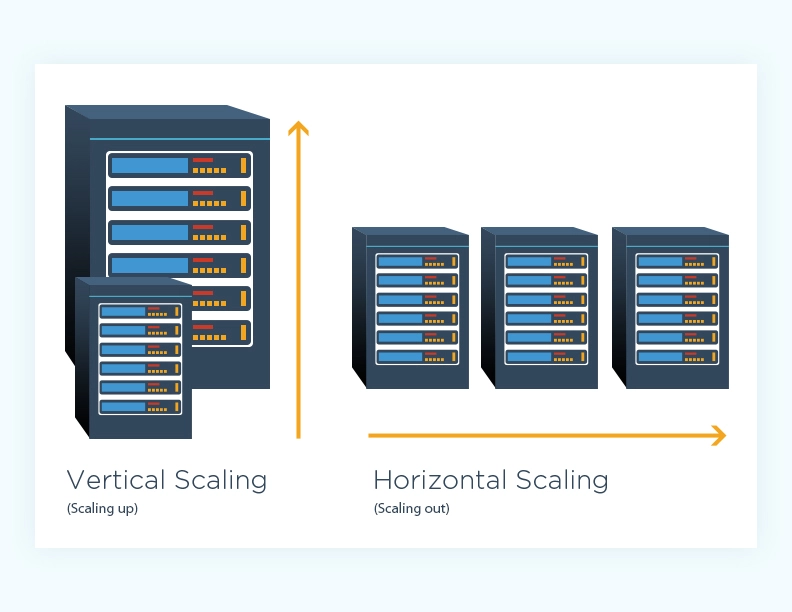Different Scaling In AWS
 Aman Manwani
Aman Manwani
Scaling in AWS refers to the ability to dynamically adjust resources to handle changes in workload demand. Scaling refers to a system's ability to handle increasing workloads without causing any disruptions to the application.
Horizontal Scaling
Horizontal scaling in AWS involves adding more instances (servers) to your application to handle increased traffic or workload as seen in blog image. This is achieved by distributing the incoming requests across multiple servers, thereby increasing the overall capacity of your system. Here's how you can implement horizontal scaling in AWS servers:
Auto Scaling Groups: Use Auto Scaling Groups (ASG) to automatically add or remove EC2 instances based on predefined conditions. You can set up scaling policies based on metrics like CPU utilization, network traffic, or custom metrics to scale out (add instances) or scale in (remove instances) as needed.
Elastic Load Balancing (ELB): Combine Auto Scaling Groups with Elastic Load Balancing for distributing incoming traffic across multiple EC2 instances. ELB automatically detects unhealthy instances and routes traffic only to healthy instances, improving fault tolerance.
Amazon EC2 Auto Scaling: Configure Amazon EC2 Auto Scaling to dynamically adjust the number of instances in your ASG based on demand. You can define scaling policies to add or remove instances gradually or in response to sudden traffic spikes.
Application Load Balancer (ALB): ALB is a type of Elastic Load Balancer that operates at the application layer (HTTP/HTTPS) and can intelligently route traffic based on different rules, such as path-based routing or host-based routing. It works well with Auto Scaling Groups for web applications.
Vertical Scaling
Vertical scaling in AWS involves increasing the resources (such as CPU, RAM, storage) of a single server instance to handle increased workload or performance demands. Here's how you can implement vertical scaling in AWS servers:
Amazon EC2 Instance Types: AWS provides a wide range of EC2 instance types with varying amounts of CPU, memory, storage, and networking capacity. You can vertically scale by choosing an instance type with higher specifications to meet your application's performance requirements.
Amazon EBS Volume Resizing: For instances using Amazon Elastic Block Store (EBS) for storage, you can vertically scale storage capacity by resizing the EBS volumes attached to the instance. This can be done while the instance is running, although a reboot may be required in some cases.
RDS DB Instance Class: If you're using Amazon RDS (Relational Database Service), you can vertically scale your database instance by changing its instance class to a higher specification with more CPU and memory resources. This can be done through the AWS Management Console or API.
Conclusion
Horizontal scaling and vertical scaling have different use cases based on the nature of your application, scalability requirements, and budget considerations. Here's a breakdown of where each type of scaling is typically used:
Horizontal Scaling (Scale Out):
Web Applications: Horizontal scaling is well-suited for web applications that experience varying levels of traffic throughout the day. It allows you to add more instances (servers) to your application to handle increased concurrent users or requests.
Microservices Architecture: In a microservices architecture, horizontal scaling enables you to scale individual services independently based on their demand, optimizing resource utilization.
High Availability: Horizontal scaling improves fault tolerance and availability by distributing workload across multiple instances. If one instance fails, traffic can be routed to healthy instances.
Vertical Scaling (Scale Up):
Monolithic Applications: Traditional monolithic applications that run on a single server can benefit from vertical scaling by increasing the resources (CPU, memory) of the server to handle increased workload or performance demands.
Database Scaling: Vertical scaling is often used for databases to increase compute capacity, memory, or storage of a single database instance. This can improve query performance and handle larger datasets.
Like ❤️ if you love my Blog and Thanks for coming Here
Subscribe to my newsletter
Read articles from Aman Manwani directly inside your inbox. Subscribe to the newsletter, and don't miss out.
Written by